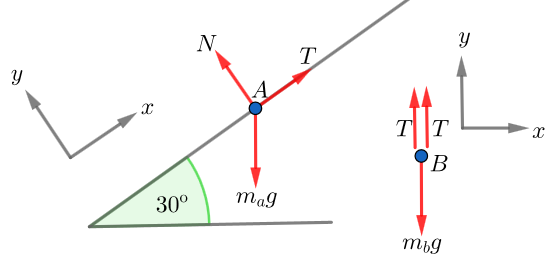EDIT: Picture doesn't show the mass of $A$$\mathrm A$. It is 60kg$60\ \mathrm{kg}$.
My attempt: I placed my coordinate system with $x-$$x$-axis parallel to the ramp surface and $y-$$y$-axis parallel to the normal force of block $A$$\mathrm A$. Here isare my free body diagrams of each block. Note how the coordinate orientations change depending on the block. Also note that I've omitted the friction force $F_f$$F_\mathrm f$ since I don't know which way it should point at this time.
Looking at the system if it is at rest, we get that for block $B$$\mathrm B$ the sum of forces in $y$ direction is
$$\Sigma F_{by}=m_ba_{by}\implies2T=m_bg\implies T=\frac{m_bg}{2}\approx 98.1 N.$$$$\sum F_{\mathrm b,y}=m_\mathrm ba_{\mathrm b,y}\implies2T=m_\mathrm bg\implies T=\frac{m_\mathrm bg}{2}\approx 98.1\ \mathrm N.$$
For block $A$$\mathrm A$ we have forces in both $y$ and $x$, thus
$$\Sigma F_{ay} = m_aa_{ay} \implies N=m_ag\cos{30}=\frac{\sqrt{3}m_ag}{2}\approx509.74N.$$$$\sum F_{\mathrm a,y} = m_\mathrm aa_{\mathrm a,y} \implies N=m_\mathrm ag\cos{30}=\frac{\sqrt{3}m_\mathrm ag}{2}\approx509.74\ \mathrm N.$$
$$\Sigma F_{ax} = m_aa_{ax} \implies T+F_f-m_ag\sin{30}=0\implies F_f=\frac{m_ag}{2}-T\approx 196.2N.$$$$\sum F_{\mathrm a,x} = m_\mathrm aa_{\mathrm a, x} \implies T+F_\mathrm f-m_\mathrm ag\sin{30}=0\implies F_\mathrm f=\frac{m_\mathrm ag}{2}-T\approx 196.2\ \mathrm N.$$
Using $\mu_s=0.25$$\mu_\mathrm s=0.25$ we find the maxmaximum friction force such that the system is starts moving: $F_{f,max}=N\mu_s=509.74\cdot 0.25=127.4N.$$F_{\mathrm f,\mathrm{max}}=N\mu_\mathrm s=509.74\ \mathrm N\cdot 0.25=127.4\ \mathrm N.$
Questions:
- How does $F_{f,max} < F_f$$F_{\mathrm f,\mathrm{max}} \lt F_\mathrm f$ imply that block $A$$\mathrm A$ slides downwards?
- When does the kinetic coefficient $\mu_k$$\mu_\mathrm k$ come into play?


